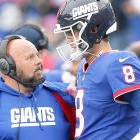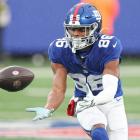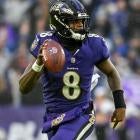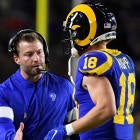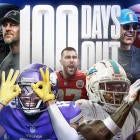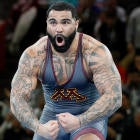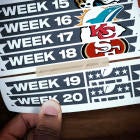Ryan Pace certainly isn't making drafting easy on himself. For a second straight year, the Bears will enter the draft with limited resources (due largely to the Khalil Mack trade). A year ago, the Bears didn't own a pick until the third round. So, what did Pace do? He gave away a 2019 fifth-round pick and a 2020 fourth-round pick to move up 14 spots in the third round and select a running back in David Montgomery (they also got a sixth-rounder back from the Patriots). The Bears wound up making only five selections in the 2019 NFL Draft, and their only pick in the top 100 was used on the least valuable position in the sport (not including kicker and punter).
This year, the Bears are entering the upcoming draft with seven picks, none of which fall in the first round. Barring another trade up, their first pick won't come until No. 43. They do, at least, pick again at No. 50. But once again, the Bears will be forced to make roster improvements with limited resources. The degree of difficulty is high, but if there's one thing Pace has proven to be skilled at, it's finding key players in the mid-to-late rounds. Yes, he has a horrible habit of giving away draft capital to go get the guy he wants. Yes, his history at the top of the draft is a disaster (allow me to introduce you to Kevin White and Mitchell Trubisky). But Pace has also found gems like Bilal Nichols, Eddie Jackson, Tarik Cohen, Nick Kwiatkoski, Jordan Howard, Eddie Goldman, and Adrian Amos all after Round 1.
With notable holes at cornerback and guard, the Bears will need Pace to work his mid-to-late round magic once again, if they're going to rebound from a disappointing 8-8 season and return to the playoffs. With that in mind, I laid out how the Bears can piece together the perfect draft. It'll never happen -- because that sort of thing almost never does. It's not entirely in their control. They'll need certain things to break their way. But -- trying to be as realistic as possible -- here's how the Bears can walk away from the draft (virtually, of course) feeling like they just hit a home-run.
Step 1: Stop trading up
It's about time Pace realized that giving up future assets in order to draft the prospect his heart desires is bad business. It's his biggest flaw -- that and identifying talent at the quarterback position. He doesn't seem to understand that the draft is largely a crapshoot and it's about giving yourself as many lottery tickets as possible. Instead, he goes all-in on his evaluations in fear that someone is going to steal the player he wants.
It's something he's done repeatedly since taking over as the Bears GM in 2015. He traded up from No. 3 to No. 2 in 2017 to take Trubisky -- giving up Nos. 3, 67, 111, and a future third-round pick to move up ONE SPOT. That same year, he traded up in the fourth round to take Jackson, parting ways with an additional sixth rounder. In 2016, he moved up in the first round to take Leonard Floyd, who was recently cut after four good, but not great seasons -- the Bears signed Robert Quinn as his replacement before cutting ties. To do so, he gave up a fourth-round pick. Later in that draft, he traded up one spot in the fourth round for Kwiatkowski in Round 4, giving up an additional sixth rounder. In 2018, the Bears traded for a second-round pick to take Anthony Miller, giving up a fourth- and second-rounder. There was also the aforementioned trade up for a running back a year ago.
What you should notice about those trades is that some of them worked out and some of them didn't. The trade up for Trubisky was an unmitigated disaster at the time, even before we knew what caliber of quarterback Trubisky would become. The trade up for Floyd wasn't a disaster, but in hindsight, the Bears would've been better off staying patient and letting the Giants take Floyd before they were on the clock. Quality players would've been available for the Bears a few picks later at their original position. Then again, their trades to move up for Jackson, Miller, and Kwiatkowski were all entirely worth it.
The point being, the draft is a crapshoot. Nobody knows which players will develop into contributors and which players won't. For every Jackson, there's a Trubisky. That's why the Bears should stop giving away future assets to go get their guy. They'd be better off saving their picks to give Pace more chances to draft useful players.
As the Bears enter yet another draft without a first-round pick, it's imperative they use their remaining draft capital in wise ways. Not trading up for a change would be a good start.
Step 2: Grab a CB, G, or S with first two picks
This mostly depends on how the first 42 picks of the draft unfold, which the Bears can't do anything about, but if the Bears are living in a perfect world, they'll fill two of their three urgent needs in the second round, where again, they have two selections at Nos. 43 and 50. Their three needs? Cornerback, guard, and safety.
After cutting Prince Amukamara to create much-needed cap space, the Bears are thin at corner. They signed Artie Burns, but Burns isn't nearly the same level of player as Amukamara. Kevin Toliver has a chance to break out after displaying signs of promise in a limited role last year, but he's still a relative unknown. The Bears need to make cornerback a priority. The same can be said for guard after starting right guard Kyle Long retired and for safety, after Ha Ha Clinton-Dix, who replaced Amos a year ago, departed in free agency.
It's entirely possible a top corner falls to them at No. 43. In a perfect world, Noah Igbinoghene out of Auburn drops to the Bears there -- an outcome that came to fruition in Ryan Wilson's latest mock draft.
It's also entirely possible a good safety prospect slips to them at No. 50 like, say, Ashtyn Davis out of Cal. In Wilson's mock, Davis went to the Cowboys at No. 51 after the Bears took quarterback Jacob Eason the pick prior. In a perfect world, the Bears wouldn't waste a valuable resource on a developmental quarterback and instead, they'd try to find immediate solutions to boost an otherwise playoff-caliber team. In Davis, the Bears would be getting Jackson a partner at safety and a player who recently made Pete Prisco's Better-Than-Team:
"The NFL has put a big premium on safeties who can run. Davis is that guy. He can cover a lot of ground on the back end with speed that enabled him to compete on the Cal track team. He is a bit raw, and he tends to go for the big hit too much, but he has the tools to become a Pro Bowl safety. He did have some injury issues that are concerning – he had a core muscle injury that required surgery – but he is expected to be ready to go for the season. "
If the Bears used their only two selections in the top 50 on Igbinoghene and Davis, their draft would be off to a perfect start.
Step 3: Acquire more draft capital
As previously mentioned, the Bears are short on draft picks. After picking at No. 50, they won't be on the clock again until the fifth round at No. 163. Their two fourth-round selections now belong to the Patriots and the Jaguars (due to the Nick Foles trade). And their third-round pick belongs to the Raiders. After No. 163, the Bears pick at Nos. 196, 200, 226, and 233. Those are the crapshoot rounds. So, the Bears should try to get themselves more lottery tickets by working the phones and hoping other teams want to pull a Pace by moving up for the guy they want.
Acquire more draft capital. That should be a goal of the Bears during the draft.
Step 4: Get a guard
After adding a safety and cornerback, the Bears still need help at guard. I would never advocate for a team to reach for a prospect based on need alone, but in an ideal world, the Bears would watch an interior offensive lineman fall to them at No. 163.
Shane Lemieux out of Oregon -- 155th on Chris Trapasso's big board -- comes to mind considering his strength (run blocking) and the Bears offensive line's weakness (run blocking). A year ago, the Bears ranked 29th in run blocking, per Football Outsiders. During his prime, Long was a beast in the running game. Finding someone who can fill that role is paramount. Lemieux would make a lot of sense here -- and I'm not saying that because Lemieux and Long share the same alma mater.
Step 5: Add depth to defense
In the late stages of the draft, the Bears should be taking the best player available regardless of position. But in a perfect world, those players would be defensive backs and linebackers. In other words, the Bears should be trying to add depth to their defense to account for injuries.
As previously mentioned, the Bears are thin at cornerback. Getting Igbinoghene would be huge, but the Bears can't depend on one rookie to transform their secondary. Adding depth here is important.
As is adding depth at linebacker. A year ago, the Bears' depth at linebacker paid huge dividends when Danny Trevathan went down with an injury and Kwiatkoski filled in admirably. Kwiatkoski's relief appearance earned him a nice contract in Las Vegas with the Raiders, so the Bears could stand to add a backup at inside linebacker behind Trevathan and Roquan Smith.
Two names that would make sense in the later rounds? Evan Weaver, a linebacker out of Cal, Trapasso's 195th ranked prospect, and college football's leading tackler last season. Utah State cornerback D.J. Williams, who ranks 189th on Trapasso's big board, would also be a good fit.
Step 6: Don't reach for a QB
I do not think either Nick Foles or Mitchell Trubisky are the Bears' long-term answer at quarterback. But I also don't think the Bears should reach for a quarterback in this year's draft.
Without a first-round pick, the only two quarterbacks that probably make sense for the Bears are Jacob Eason and Jalen Hurts. But those two quarterbacks are incredibly flawed. Their chances of developing into franchise-level quarterbacks are slim.
Instead of using a second-round pick on a quarterback, the Bears should try to upgrade other areas, as previously outlined. They should go all in with Foles/Trubisky for one season. If the Bears make the playoffs with Foles or Trubisky? Great, their plan worked. Either their otherwise good roster was able to overcome so-so quarterback play or Foles/Trubisky played better than expected. If the Bears do not make the playoffs, their otherwise good roster was not able to overcome so-so quarterback play and Foles/Trubisky did not play better than expected. In that scenario, the Bears would likely have a decent first-round pick in 2021, which they can then use on a quarterback prospect better than Eason and Hurts.
Go all in with this core in 2020. The Bears already won eight games without a quarterback a year ago. With only marginally better quarterback play, they can be a playoff team. If it doesn't work, draft a quarterback in a year, when the Bears actually have a first-round pick and a chance to draft a quarterback with a decent chance of developing into the savior they've been looking for at the quarterback position since, well, forever really.














